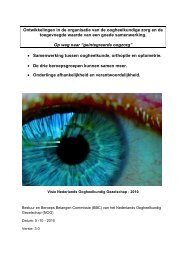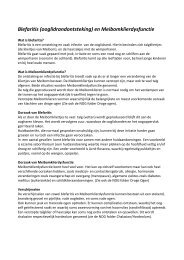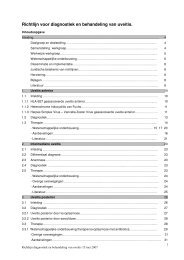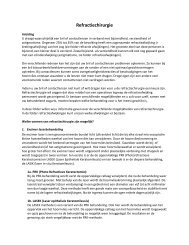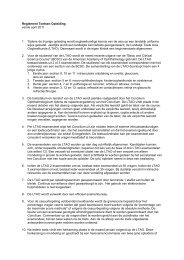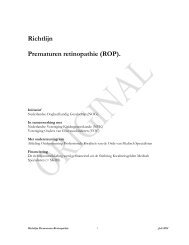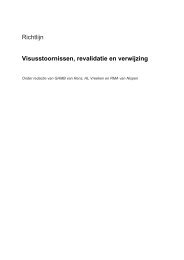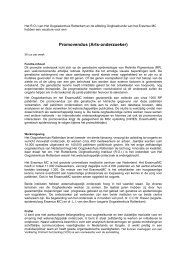terminology and guidelines for glaucoma ii - Kwaliteitskoepel
terminology and guidelines for glaucoma ii - Kwaliteitskoepel
terminology and guidelines for glaucoma ii - Kwaliteitskoepel
Create successful ePaper yourself
Turn your PDF publications into a flip-book with our unique Google optimized e-Paper software.
3.3.1.3 - Category: CARBONIC ANHYDRASE INHIBITORS 46<br />
Generics<br />
Tradenames<br />
Topical: Brinzolamide 1% Azopt<br />
Dorzolamide 2%<br />
Trusopt<br />
Systemic: Acetazolamide Diamox, Diamox Sequels, Diamox Retard<br />
Dichlorphenamide<br />
Methazolamide<br />
Antidrasi, Daranide, Glaumid, Oralcon<br />
Neptazane<br />
Action<br />
Topical: Carbonic anhydrase inhibitor. Reduces aqueous <strong>for</strong>mation resulting in lowered IOP.<br />
Systemic: Carbonic anhydrase inhibitor. Reduces aqueous <strong>for</strong>mation resulting in lowered IOP.<br />
Dosage <strong>and</strong> administration<br />
Topical: Dorzolamide 2% Monotherapy: three times daily.<br />
As adjunctive therapy with topical betablocker: two times daily<br />
Brinzolamide 1% Monotherapy: two - three times daily<br />
As adjunctive therapy with topical betablocker: two times daily<br />
Systemic: Acetazolamide 250 mg tablets (given QID as full dose)<br />
500 mg slow- release capsule (given BID as full dose)<br />
Dichlorphenamide 50 mg 1-3 times daily<br />
Methazolamide 50-100 mg 2-3 times daily<br />
Indications<br />
Topical: Elevations of intraocular pressure in patients where the IOP can be deleterious <strong>for</strong> the<br />
preservation of visual function.<br />
Systemic: When topical medications not effective or feasible. When long-term systemic CAI are needed, <strong>glaucoma</strong><br />
surgery should be considered.<br />
Major contraindications<br />
Topical: Hypersensitivity to any component of the product<br />
Systemic: Contraindicated in situations in which sodium <strong>and</strong>/or potassium blood levels are depressed, in cases of<br />
kidney <strong>and</strong> liver disease or dysfunction, in suprarenal gl<strong>and</strong> failure, <strong>and</strong> in hyperchloremic acidosis.<br />
Precautions<br />
Topical: For the treatment of acute angle-closure <strong>glaucoma</strong> attack with corneal edema <strong>and</strong> inflamed conjunctiva,<br />
systemic CAI treatment is preferable.<br />
In patients with low corneal endothelial cell count, there is increased risk of corneal edema.<br />
Since no data on patients with severe renal impairment (CrCl < 30 mL/ml) are available, they should not<br />
be used in such patients. The concomitant use of topical <strong>and</strong> oral carbonic anhydrase inhibitors is not<br />
additive <strong>and</strong> not recommended.<br />
These compounds are sulfonamides; the same kind of adverse reactions that are attributable to any sulfonamide<br />
may occur.<br />
Systemic: Increasing the dose may increase the incidence of drowsiness <strong>and</strong> /or paresthesia. Adverse reaction common<br />
to all sulfonamide derivatives may occur like anaphylaxis, fever rash (erythema multi<strong>for</strong>me),<br />
Stevens-Johnson syndrome, bone marrow depression, thrombocytopenic purpura, hemolytic anemia,<br />
leukopenia, pancytopenia <strong>and</strong> agranulocytosis. Some of the above can be irreversible <strong>and</strong> lethal. If the<br />
patient is on another diuretic orally periodic monitoring of serum electrolytes is indicated.<br />
Ch. 3 - 14 EGS



